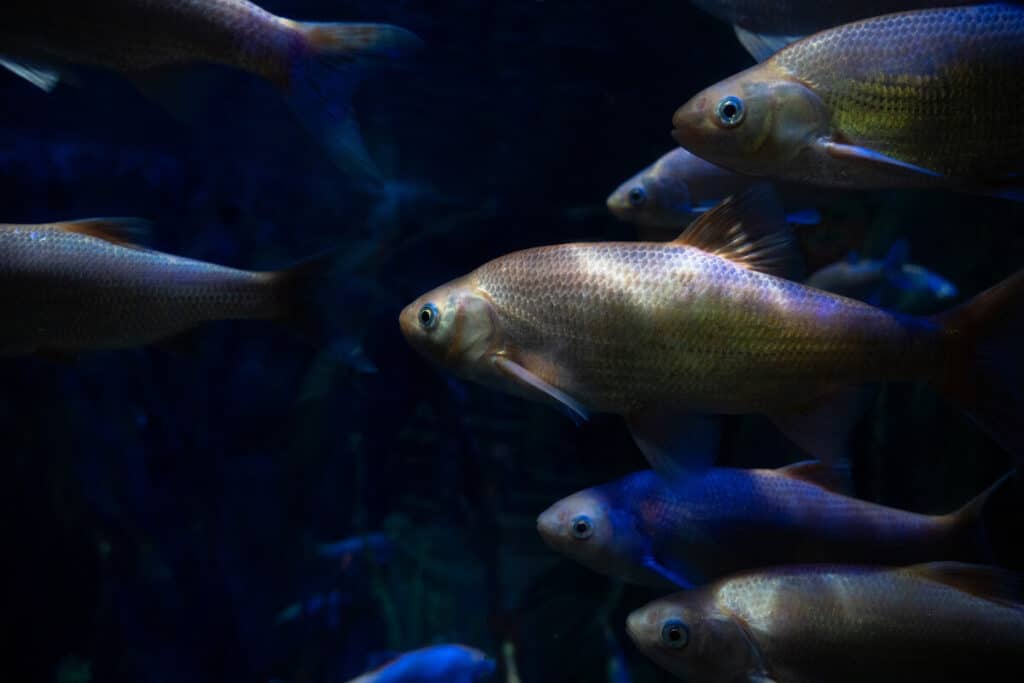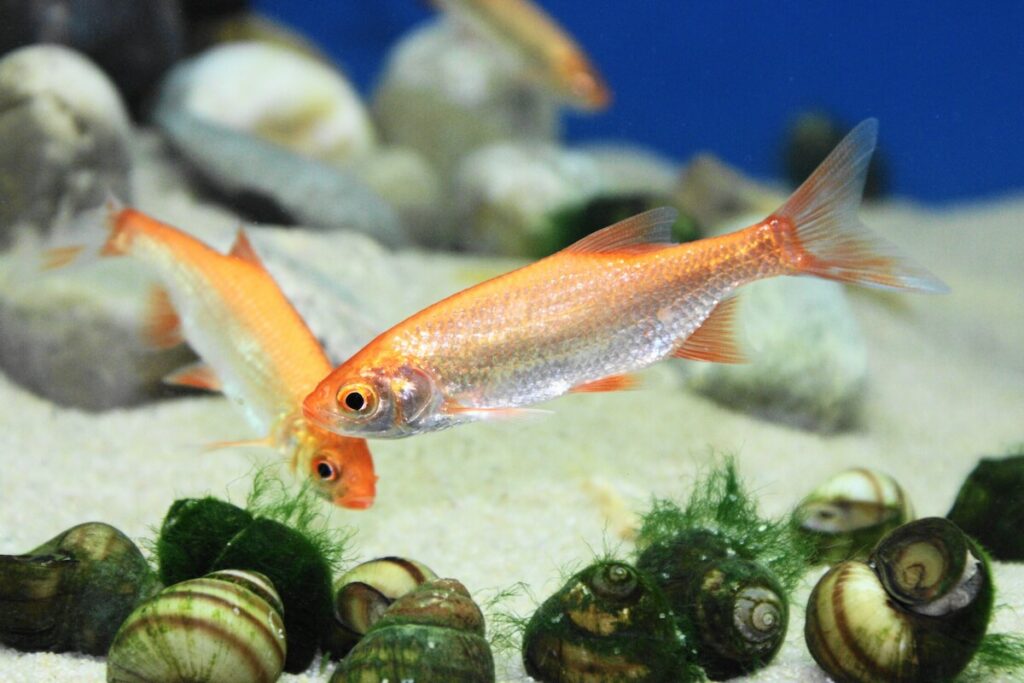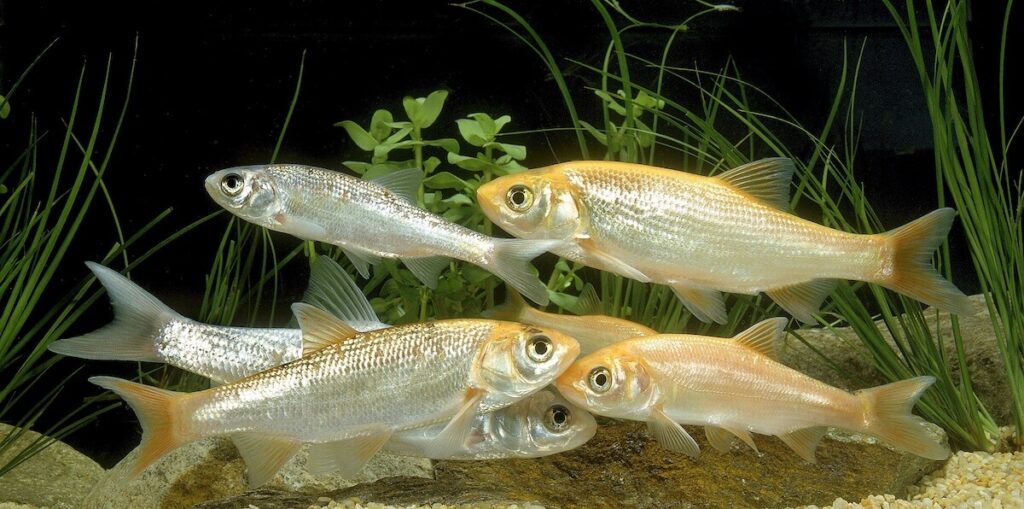the essentials in brief
Golden Orfs living in a garden pond feed on algae, aquatic plants, insect larvae and small aquatic organisms.
Suitable fish that can be kept with golden orfe are peaceful cold water species such as zebrafish, veiltails or platys. Read more here...
Gold orfes can reach a size of around 15 to 20 centimeters in aquariums, while in ponds they can even reach up to 30 centimeters or more under optimal conditions. Read more here...
Are you curious about the fascinating underwater world? Then dive with us into the world of the golden orfe - a charming freshwater fish that not only impresses with its shiny appearance, but also with an interesting history and ecological importance. In this post, I'm going to tell you everything you need to know about the golden ore, from their appearance to their behavior and impact on our waters.
The dazzling appearance of the golden orfe

Imagine you are walking along a quiet pond and suddenly a golden fish catches your eye. It is the golden orfe that shines like a sparkling jewel in the water with its shiny exterior.
Their scales reflect the sunlight in a way that simply enchants you. But did you know that there is not only one color variant of the golden orfe?
The golden orfe, also called Carassius auratus, can occur in different shades. From an intense Golden yellow to a soft orange-red the color palette is as varied as it is impressive.
Tip: Make sure the golden orps get a balanced diet that includes both dry food and fresh foods such as vegetables and insect larvae.
These color variations can result from breeding, but natural factors also play a role. It is fascinating that these colorful creatures not only enhance the waters, but can also be a reflection of natural diversity.
An Orfe (Carassius auratus) can reach different sizes depending on the conditions in which it lives. Orfs can grow significantly larger in a pond or natural body of water where they have more space than in a confined aquarium.
As a rule, gold orfes in aquariums reach a size of about 15 to 20 centimeters. However, this is only a rough estimate as size can be affected by a number of factors including water quality, diet, space available and general maintenance.
In the wild or in large ponds, golden orps can even reach a length of 30 centimeters or more under optimal conditions. It is important to note that fish growth in a confined space such as an aquarium can be more limited as the space and environmental conditions are not as ideal as in natural bodies of water.
Origin and distribution of the golden orfe
The orfe is a creature with a rich history that spans continents. Originally native to the cold rivers of Eastern Europe, it was discovered and admired by humans centuries ago. Its beauty led it to be kept and bred as an aquarium fish, spreading it all over the world.
Note: Regularly monitor the behavior and appearance of the golden orfs to identify early signs of illness or stress.
Over time, golden ores were not only kept in aquariums, but also exposed in ponds, lakes and calm rivers. This has resulted in them becoming native to many parts of the world. From Europe to North America, from Asia to Australia, the golden orfe has left its iridescent mark and consolidated its presence in the water.
Today, the golden orfe is a prime example of the impact of human activity on the environment. Their inadvertent introduction into non-native waters can cause ecological imbalances and endanger native species. For this reason it is important for the attitude and to be sensitized to the release of gold orfe and to deal with it responsibly.
A look at the behavior of the golden ore
Not only their appearance, but also their behavior under water is fascinating. Gold orfs often swim in groups called schools. As well as being a sight to behold, these group swimmers serve an important purpose. By swimming in a group, they are better protected from predators, as the larger mass deters potential attackers.
The social interactions within the groups are also remarkable. one can observe how the fish glide through the water in harmonious movements, almost as if they were dancing together. This behavior is not only protective, but also promotes social cohesion and allows the gold orfs to learn from and adapt to each other.
The ecological importance of the golden orfe
Now that we know more about the appearance and behavior of golden orfe, let's take a look at their ecological importance. These fascinating fish play an important role in the aquatic ecosystems in which they live. Small aquatic insects, algae and plant remains are on their menu.
Additional information: Depending on the conditions, golden orfes can exhibit a variety of color variations, ranging from an intense golden yellow to a soft orange-red.
By eating algae, gold ores contribute to that Control algae growth and keep the water clear. They also improve habitat for other organisms by churning up the soil and releasing nutrients. This role as the "health police" of the waters shows just how big an impact these humble fish can have.
Care and husbandry of the gold orfs
Anyone who is now enthusiastic about the gold orfs and is toying with the idea of keeping them yourself should note a few important things. Keeping golden orfs requires a sense of responsibility and knowledge of their needs.
Attention: Don't forget that golden orfes are peaceful fish, but care must be taken to ensure the right social partners in the aquarium in order to avoid conflicts.
They prefer cooler water and need it enough space to move freely. The water quality is crucial for their health.
The diet of golden orfe should be balanced and both dry food and fresh food such as vegetables and insect larvae contain. Because these are sociable fish, it is advisable to keep them in groups to encourage their natural behavior.
Keeping golden orps in aquariums: tips and tricks

Keeping golden orps in the aquarium can be a fascinating experience, but it requires careful planning and attention to certain factors to provide these brilliant residents with optimal conditions. Here are some important tips and advice:
Aquarium and group size: Golden Orfs are social fish and should therefore be kept in groups to encourage their natural behaviour. A spacious aquarium is required to ensure adequate group size. For every gold orfe should at least 40-50 liters of water are available.
Water quality and temperature: gold orf prefer cooler water. The water temperature should be between 18°C and 23°C. A good filter is essential for water quality. A regular partial water change is also important to reduce pollutants.
Setting up the aquarium: The setup of the aquarium should include natural hiding places, plants and a gravel bottom. Gold orfes like to nibble on plants, so hardy species should be chosen. Avoid sharp or pointed decorations to avoid injury.
Keeping gold ores in the pond
Keeping golden orps in a pond can be a great way to experience these fascinating fish in a more natural environment. A pond should enough space provide and be well planted to create hiding places.
Make sure the pond has a sufficient depth to ensure that the gold orfs are protected even in cold seasons. Water quality and a balanced diet are just as important as in aquarium keeping. Note that golden orps in the pond can also be attractive to other animals such as birds or cats, so make sure the pond is adequately protected.
Nutrition: A golden orf's diet should be balanced and include a variety of food sources. Dry food, frozen food like mosquito larvae or Artemia and vegetables such as peas can be part of the lining. Be careful not to overfeed to avoid overfeeding and water pollution.
Caution when socializing: Gold orfe are peaceful fish, but not all species are suitable social partners. Avoid aggressive or overly large fish species that could stress or attack the gold orfs. Other peaceful cold-water fish such as zebrafish or platys are good companions.
Gold Orfs - A shining treasure of the underwater world
Now you know the fascinating history, impressive appearance and ecological importance of the golden orfe. These shiny freshwater creatures are more than just eye-catchers - they are an important part of our water bodies and deserve to be admired and protected. Whether you immerse yourself in the world of the golden orfs or simply appreciate their fascinating existence, one thing is certain: these fascinating fish will always cast a spell over you.



